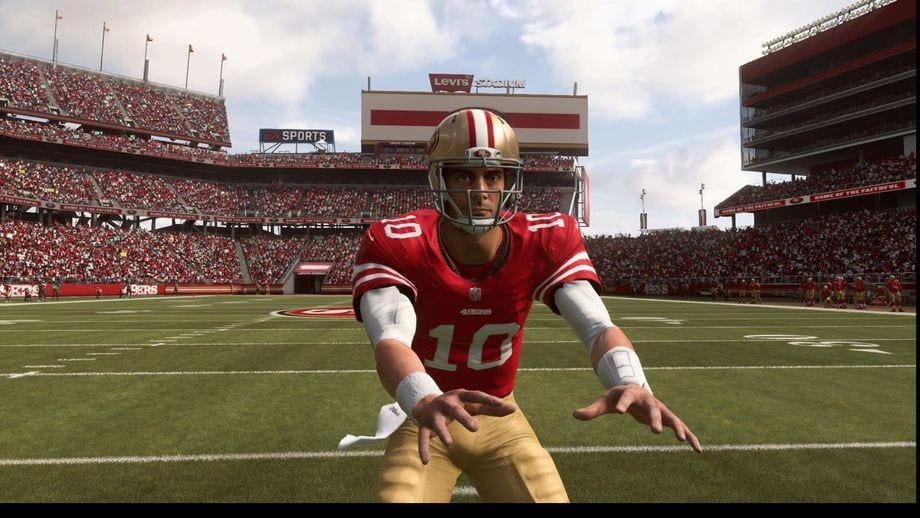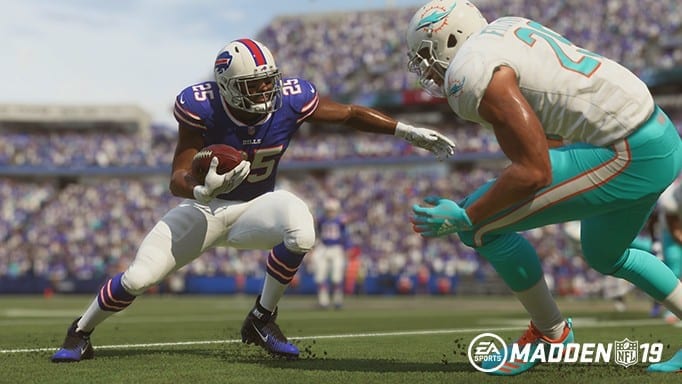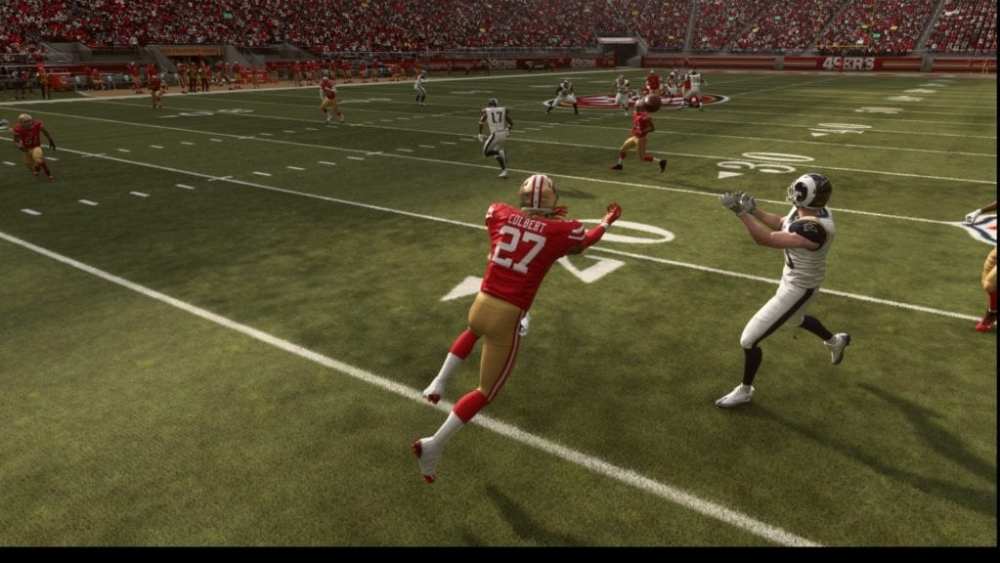With the release of Madden NFL 19, fans the world over will be diving deep into a game that has come ever closer to exorcising the demons of the past. With most Madden releases making small improvements here or minor tweaks there, EA’s football game can feel somewhat samey year over year. Fortunately, Madden NFL 19 bucks that trend thanks to a huge leap forward in the fundamental way players move on the field. In our Operation Sports impressions roundtable, I described this year’s game as one of the best football games EA has made in years, and I stand by that. It isn’t perfect by any means, but it’s so much more than the typical “roster update” accusation normally leveled at Madden. Today, I’m breaking down offensive gameplay and how the new gameplay systems have altered Madden on a fundamental level.
Disclaimer: All games were played on All-Pro Simulation.
Running Game
- Real Player Motion has really changed the way running happens. Momentum and patience are keys to employing a successful running game. Most of the instant cuts and unrealistic speed boosts from last year are gone. At first, I really struggled to get a feel for the new running game and I had to really let go of old Madden habits to be successful, but once I got through the learning curve I found running the ball to be a more realistic and rewarding experience.
- The biggest change myself and many other players will have to make is not immediately smashing down speed burst. This is especially true for getting to the edge. In Madden 19, the offensive line does a better job of holding blocks provided you aren’t hitting the turbo too soon. Patience is key and allowing blocks to develop is the only way to have success in the running game. In fact, be prepared for block sheds galore until you ease off of the speed burst behind the line.
- One of my biggest gripes with Madden 18 was that running between the tackles quickly became an exercise in tripping over your own lineman in the hole. I can’t count how many times I was essentially tackled by my own man despite having nothing but wide open spaces in front of me. Thankfully, that is now fixed with the “Hit the Hole” mechanic. Holding the right stick up allows the running back to get through the hole even when stuck behind a blocker. In the case of a smaller back, the runner will put his hand on the lineman and try to maneuver around them, even to the point of being able to spin off the block. For power runners like Derrick Henry, they can truck the defender off of the block.
- Speaking of the differences between the different types of backs, smaller, quicker RBs have a different stride from the larger, more lumbering power backs. Also, a bigger back will have an easier time bowling through smaller defensive backs. In my play time, I noticed a distinct difference in how quickly a small back like Jerrick McKinnon was pushed back as opposed to the aforementioned Henry.
- Running down near the goal line has been improved but only marginally so. The “Push the Pile” mechanic is more an extension of the “Hit the Hole” aspect than for short-yardage situations. By improved, I mean that I didn’t suffer instant two-yard losses when trying to use a goal-line formation on the one-yard line. Short yardage running remains one of the weakest aspects of running the ball. The offensive line blocks exactly the same in short yardage as they do when there’s more real estate to work with.
- The other weak aspect of the running game remains second-level blocking. Despite linemen being able to better identify assignments up the field, blocks are missed or instantly shed far too often. Because of this, one on ones at the second level never really happen. Countless times I made a move on the DB with no one around, only to catch a hit stick from a defensive lineman that somehow made it back into the play. It takes away some of the breakaway potential of the better backs out there and means that long TDs will mostly happen when having a clean hole without the need for a ball-carrier move.
- “One Cut” is the best ball-carrier move in the game. It provides the biggest and fastest change of direction available to each running back. To do this, you have to move the left stick to the direction you want to go and then hit the speed burst when your back plants his foot. It requires a bit of practice to get down, but you’ll know you’re doing it right due to the visual cue of grass flying up.
- Ball-carrier moves are still really good and in Madden 19; they can be immediately branched into one another. I had numerous instances where I juked one defender, and then immediately trucked or spun away from a second defender closing in. The system feels responsive and looks really good. It’s definitely a welcome addition to the running game.

Passing Game
- Target Passing is gone from Madden NFL 19. While a cool concept, it wasn’t implemented well, and I prefer having the left triggers dictate high and low point passing. L1/LB is still high point passing while low point passing goes back to L2/LT like it was in Madden NFL 17.
- Jumping RAC animations are no longer in the game. This particularly affects the deep ball and end-zone situations. Now when high point passing, the receiver has to do an aggressive catch to make the play. This adds a layer of strategy to the WR/DB interactions and prevents things like the RAC Swerve from Madden 18.
- Outside of the new pre-play QB animations, there is still little to no difference between how the QBs throw the ball. Sure, an Aaron Rodgers will throw less wayward passes than a Jameis Winston, but there aren’t any differences in passing speed or trajectory between the different quarterbacks in the league. Even when creating a QB, we’re still stuck with the same release options we’ve had for the past few years. Where they do differ is in their tendencies. I saw Case Keenum escape the pocket and instead of running, he threw the ball downfield. This is in direct opposition to Russell Wilson, who took off with his legs to get yardage. Even more than ever, the difference in speed between a Tom Brady and a Lamar Jackson is pronounced.
- Getting the ball out quickly is also more important than ever in Madden 19. The pass rush is on point this year, and the time you have in the pocket has been shortened. This is especially true on HB screens and on play-action passes. The defense will get in quickly, and players have to make the throw immediately or end up eating a sack. On normal pass plays, the line does a good job of allowing the QB to climb up into the pocket and make throws. In fact, even when taking off to run with the QB, it’s often more effective to step up and through the line as opposed to rolling out and getting to the edge.
- Touch passing is still too floaty in my opinion. It doesn’t have enough speed on the ball and so it allows defenders to catch up to the pass. This is especially problematic when trying to throw against cover 2. Firing a bullet pass often results in an interception by the LB lurking in the middle, but using a touch pass allows the defenders to close too quickly and often ends up in an incompletion because the receiver gets smashed upon catching the ball.
- Drop animations have been added to Madden 19. It’s been a much welcomed addition, too. In the past, receivers would drop the ball but wouldn’t give any indication as to why they dropped it. It would literally roll out of their hand. This year, you’ll see a receiver actually bobble a ball and reach out for it. It’s more of a visual indicator than anything but adds to the immersion of the game. On another note, WRs drop less passes this season, which is also a welcome change.
- Passing windows are tighter this season and that’s largely due to the improvements in man coverage. Fortunately, throwing into those tight windows is more than possible. With the decrease in dropped passes and the refinement to the WR/DB battles, it’s no longer an automatic interception if the defender is only a yard or two behind. That said, the diving catch animation from the receivers is comically fast. They’ll almost warp a couple yards to make the catch. Not only that, but occasionally you’ll still see a defender sometimes get a speed burst to bat a ball down. Tight-window throws are much improved but could still use refinement.
- Receivers seem to be way too slow right after catching a pass. Cutting up the field takes too long and momentum comes to a halt allowing the defender to catch up too quickly. This is most notable on crossing routes when trying to turn up the field to get extra yardage. A small solution to this is to use a ball-carrier move or one cut to make it up field, but it’s definitely a step back form last year.
Miscellaneous
- Offense, as a whole, still feels a step slower than the defense. Despite bumping up speed since EA Play and the beta, Madden 19 still sees far too many instances of defenders catching up to a breakaway. I’ve even had 98 speed Tyreek Hill have defenders closing the gap on him in the open field. Because this seems to be from the Real Player Motion system, I’m unsure if the speed threshold slider will make any difference.
- Special teams are untouched outside of the elimination of wedge blocking, which Madden didn’t really ever do anyway. You’ll still know exactly when your kick is going to be blocked, and selecting the blocker in front of the kick returner and moving him up field and to the side before the kick is caught will still make the returner able to get more yards.
- One of the more troubling things in Madden NFL 19 comes on fumbles and interceptions. For fumbles, there are far too many leapfrog animations, and players will whiff on the fumble recovery just like in the past. Fumbling and fumble recovery is something that needs a complete overhaul. For interceptions, the WR will sometimes enter an animation where he is showing frustration with not catching the ball, and this allows the defender who intercepted the ball to run right by the receiver and continue to get yards on the return. This type of animation is irritating since you can’t switch to or move that player to make a play on the ball. Hopefully, this gets removed.
- Rolling out with a QB away from his throwing arm causes him to have to set his feet and turn his body completely before throwing the ball. This looks like another side effect of the RPM system. While it looks more realistic than a ball flying off a QB’s hand 60 yards across his body, just keep in mind you’ll need an extra second or so before the ball comes out.
- There is still no option to shift protection for the run. Of course, it’s still there for the passing game but being able to shade blocking to match the defensive alignment for the run would have been a welcome addition.
- Still no RPOs in the game. This has been explained but it’s still something that is sorely missed.
Typically, sports games see little improvement due to the shortened development cycle, but EA has done a great job with Madden NFL 19. That being said,It’s not a perfect game of football and many legacy issues still persist. Some new issues have also shown up due to the Real Player Motion system. However, the positives of RPM far outweigh the negative and fundamentally changes the way Madden is played. I’ve had more fun with this iteration of the game than I’ve had in a long time, and I stand by my statement that Madden NFL 19 plays one hell of a game of football and is the best Madden game in years.
Stay tuned for my Defensive Gameplay Breakdown in the coming days.










Published: Aug 10, 2018 05:54 pm